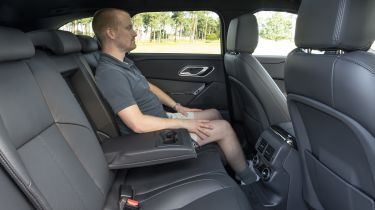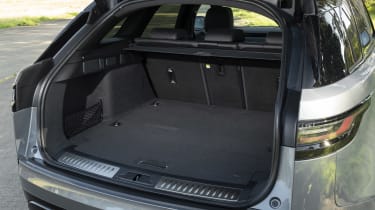Range Rover Velar review - Practicality, comfort and boot space
The Velar features Active Noise Cancellation technology and offers the levels of comfort you’d expect from any Range Rover-badged product

The Velar sits between the compact Evoque and the Range Rover Sport – our reigning Large Premium SUV of the Year – and as such its dimensions fall neatly between the two models. It’s a very roomy SUV, but not the best option for those who regularly carry three passengers in the rear – for reasons we’ll get into shortly. If you just need room for four though, the Velar is an excellent option.
Boot space is equally generous, but cabin storage is average – there’s a large glovebox, the door bins are fairly deep and the central storage bin is reasonably roomy, although it’s not that wide. As a result, it’s a bit of a squeeze to fit a large smartphone inside – especially if you choose to plug it into one of the USB sockets. There’s also a 12-volt socket in the same cubby. Rear passengers also get a set of USB-C charging ports to keep their devices topped up, with two sets of ISOFIX mounting points back there for child seats as well.
Size
The Range Rover Velar measures in at 4,797mm long, 2,041mm wide and 1,683mm tall. In other words, it’s about the same length as a Porsche Macan, but the Velar is taller and wider. The Velar is relatively easy to get into compared to larger Range Rovers thanks to its lower driving position, and if you go for Dynamic HSE trim or above, the air suspension can go into ‘Auto Access’ mode that lowers the car by 40mm when you reach your destination, making it even easier to get into and out of.
Leg room, head room & passenger space
Sitting up front in the Velar is not quite as majestic as the large Range Rovers, but you still get a commanding view of the road ahead and it’s very easy to get comfortable. There’s also plenty of adjustment in the supportive seats as well as in the steering column, so finding a good driving position is no problem.
Used - available now

2020 Land Rover
Range Rover Velar
31,350 milesAutomaticDiesel2.0L
Cash £20,995
2020 Land Rover
Range Rover Velar
74,400 milesAutomaticDiesel2.0L
Cash £18,495
2020 Land Rover
Range Rover Velar
71,590 milesAutomaticDiesel2.0L
Cash £20,495
2021 Land Rover
Range Rover Velar
18,555 milesAutomaticPetrol2.0L
Cash £31,000Meanwhile in the rear, there’s a very impressive amount of kneerom and the cabin itself is wide, plus the two outer seats are nicely sculpted, making it very easy for two six-foot adults to get comfortable. However the Velar is best suited for carrying two in the back, rather than three, as the centre seat is quite slim, the backrest is hard, and the central tunnel is quite high, so there’s little space for the middle passenger’s feet.
Boot
Petrol and diesel-powered Velars have a 552-litre boot, while the plug-in hybrid offers 503 litres of space because of the battery located under the boot floor. Nevertheless, the load bay is almost perfectly square, and the large boot opening makes it easy to stack items inside. You get four hooks to tie things to, while a sturdy load-lip protector means you don’t have to worry too much about causing damage when lifting heavy luggage in. Unfortunately, unlike in the Range Rover there’s no split-tailgate.
Every Velar features a 40:20:40 split rear bench, and dropping the rear seats expands the luggage capacity to 1,358 litres in petrol and diesel models, or 1,335 litres in the plug-in hybrid.
Towing
The Velar’s towing capacity depends on which engine you select. The plug-in hybrid P400e can haul up to 2,000kg, the cheaper D200 and P250 can tow up to 2,400kg, while the more powerful D300 diesel and P400 petrol have a maximum towing capacity of 2,500kg. However, all Velars can only tow up to 750kg on an unbraked trailer.










